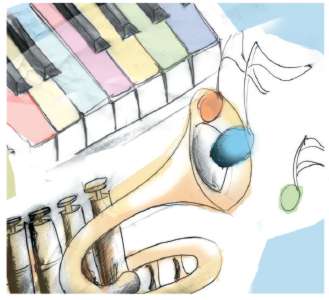
 Imagine
listening to Miles Davis' Kind of Blue and seeing
the musical notes as a beautiful cascade of colours. It
may sound wonderful — but what if, also, every time
you heard a vacuum cleaner you felt an itch between your
toes? Welcome to the world of synaesthesia, a condition
where so-called 'synaesthetes' perceive stimuli to one
sense (like smell) simultaneously with one or more of
the other senses (such as sight or hearing). Imagine
listening to Miles Davis' Kind of Blue and seeing
the musical notes as a beautiful cascade of colours. It
may sound wonderful — but what if, also, every time
you heard a vacuum cleaner you felt an itch between your
toes? Welcome to the world of synaesthesia, a condition
where so-called 'synaesthetes' perceive stimuli to one
sense (like smell) simultaneously with one or more of
the other senses (such as sight or hearing).
"Synaesthesia is a subjective experience
so the only way to know about it is through what people
tell us," says Dr Phil Merikle, a psychologist and co-director
of the Synaesthesia Research Centre at the University
of Waterloo. The most common form of synaesthesia is
grapheme synaesthesia, where colours are associated
with letters and digits. Seeing the letter "Q" might
trigger a vision of green, while the number "5" might
trigger a fuchsia explosion. For some synaesthetes,
a specific sound — such as birds chirping outside
the window — might cause them to see streaks of
purple. For others, a word such as "poetry" might trigger
the smell of bubble gum. While some synaesthetes literally
experience these second senses, others only experience
the association in their mind.
MYSTERIOUS
CAUSES
As for what causes the condition, the jury is still
out. "There is a lot of speculation right now," says
Dr Merikle, who was once told by a synaesthete that
his name made her taste peanut butter. One generally
held belief is that the condition is rooted in a neurological
anomaly. But some evidence suggests that synaesthesia
can also be passed on genetically.
Dr Daphne Maurer, a psychologist
at McMaster University, suggests we are all born with
the condition, but our nervous system develops by "pruning"
neurons and eventually separating our senses. Synaesthesia
therefore develops when the pruning process is incomplete.
"Exactly what's [causing it] is
where much research is going on," says Dr Elizabeth
Pector, a synaesthete and family physician in Chicago.
"We know there may be some association with attention
deficit disorder or autistic disorders." But not everyone
views synaesthesia as a problem to be cured.
"Some synaesthetes see it
as more of a trait or a different way of seeing the
world, rather than something that is to be treated or
fixed," says Dr Pector.
There may even be a 'mystical'
component to synaesthesia: a recent paper by Dr Jamie
Ward in the October issue of Cognitive Neuropsychology
suggests that the coloured "aura" seen by psychics and
healers may be a rare manifestation of the synaesthesia
where people associate colours with emotions.
THE
COLOUR OF MUSIC
Some of the most famous synaesthetes are prominent musicians.
It's questionable if we really would have wanted to
'cure' synaesthete trumpeter Miles Davis — whose
Kind of Blue inspired a whole new era of 'cool'
jazz. Elvin Jones, the legendary jazz drummer, associated
colours with his cymbals and drums. And virtuoso violinist
Itzhak Perlman is widely believed to be a synaesthete,
though he has been known to deny having the condition.
Synaesthetes may have an advantage in music, since they
are able to "see" the notes in addition to hearing them
says Dr Merikle. But like Mr Perlman, many with the
condition are either unaware they have it or choose
to not acknowledge it in order to avoid being seen as
different.
"It is important for doctors to
know about [synaesthesia] because they could have people
coming in [with it]," says Dr Merikle, whose research
is challenging long-held views of the condition.
"Up until a year ago, everyone
accepted that one in every 2000 people has synaesthesia,"
he says. "The other accepted number is that there is
a 5:1 or 6:1 female to male ratio for synaesthetes."
New research from his group and others finds that one
in 200 people may have the condition, and that there
might not be a gender bias at all.
Though there are accepted tests
for diagnosing certain types of synaesthesia, the condition
is not curable and there are no treatments — which
may be a good thing for the future of music.
For more on synaesthesia visit
Dr Pector's site: www.synspectrum.com
and the Synaesthesia Research Centre: www.synaesthesia.uwaterloo.ca
|